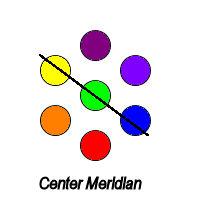<<Contents -1.0 - 2.0 - 3.0 >>
1.0
The Meridian light Code
The Four Meridian Sets
The colours as arranged in linear form, create a combination of four 'creative' colours; (red , yellow , blue and violet) and three 'created' colours (orange, green and indigo). This is made up of the difference between red and yellow creating orange, yellow and blue creating green and blue and violet creating indigo.
Due to the placement along the spectrum, this creates a subset or interconnection of three sets within the seven colours, named the Orange Meridian (lower) Green Meridian (center) and Indigo Meridian (upper). The center created colours rest between the two respective creative colours.This means for example the difference between red and yellow (half of each) is orange. Red, yellow, blue and violet are referred to as the creative colours. Orange, green and indigo are the created colours. Another point is the fact of the subsets being connected as they are. The orange meridian center and the indigo meridian center are both connected to the central green meridian set, via yellow and blue respectively.
Linear Meridian Flow
Placing this linear spectrum into a spherical one, allot more information can be seen. Called the Linear Meridian Flow, it is designed with the center meridian where it should be presented... in the center, and the other colours placed in a sensible order around the center.
The center meridian set becomes the most prominent set. The configuration of the spectrum in this way also represents the opposites of direction of flow, ie, from red to yellow is clockwise, yellow to blue is neutral and blue to violet is anti-clockwise. It also represents another aspect of meridian light, that is the attraction of duality; of equal opposites (also connected to the properties of light below). In the meridian diagram below , this duality is shown with the connection of red , violet and green. This represents opposite ends of the spectrum, also indicating that with green still in between, the difference between the two is also green, resulting in the fourth subset. Otherwise known as destination (red), source (violet) and transition (green). This is called the Transitional Meridian.
From this same pattern we can also see the three creative meridian centers can connect in a straight line (orange, green, indigo), and the entire green meridian is also apparent in a line. Note that the green meridian is both part of the set of all three meridians, and also a separate set unto itself, as will be explained further in this site. These four aspects form the Four Meridian Sets and are all indicated within the Linear Meridian Flow. Note that there are only three lines of flow, the three meridian centers are represented in one line, with the entire green meridian set seen also as a separate line, and the transitional set as the last. This simply notes the importance of the green meridian as a central and integral part of the whole structure of meridian light.
<<Contents -1.0 - 2.0 - 3.0 >>
`:)(:~





